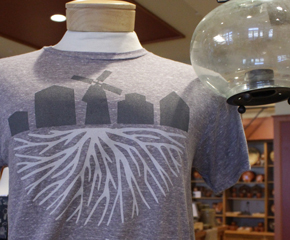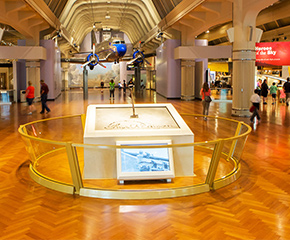
Detroit Publishing Company Collection
The Detroit Publishing Company was one of the major image publishers in the world for nearly 30 years from 1895 to 1924. The company produced prints of landscapes and city scenes across the United States and around the world. Incorporated in 1895 as the Photochrom Company in Detroit, Michigan, it was known until 1905 as the Detroit Photographic Company, and then the Detroit Publishing Company. The collection consists of photographic prints, postcards, and color prints with subjects dating from the 1880s through the 1910s.
Biographical / Historical Note
The Detroit Publishing Co. became a comprehensive publisher of photographic images around the turn of the century. Started in 1895 in Detroit, Michigan, it was known until 1905 by its two subsidiary operations, the Photochrom Co., dealing with the
MoreThe Detroit Publishing Co. became a comprehensive publisher of photographic images around the turn of the century. Started in 1895 in Detroit, Michigan, it was known until 1905 by its two subsidiary operations, the Photochrom Co., dealing with the production of color prints, and the Detroit Photographic Co., responsible for the publishing and distribution of photographic views made by the company. A timely joining of entrepreneurial energies helped assure the early success of the company.
William A. Livingstone (an engineer and son of wealthy Detroit shipping magnate, newspaper publisher, and financier, William Livingstone, Jr.), joined forces with a local photographer, Edwin H. Husher, to form the company. Husher and Livingstone obtained from the Photoglob Company of Zurich, Switzerland, the North American rights to an astounding new photolithographic process called Photochrom, to produce, in quantity, color prints that retained their photographic verisimilitude while capturing the vibrant colors of the popular chromolithographs of the late nineteenth century. Husher even persuaded an expert in the process, Albert V. Schuler, and a small crew of draftsmen from Switzerland to work for the new company. Since color photography as we know it did not then exist, holding exclusive rights to this Swiss method gave the company a significant advantage over its competitors. Besides producing these distinctive Photochrom color prints, the company also published color postcards, sepia-toned photographic prints, and lantern slides, all based on a huge inventory of photographic negatives.
The keystone of the company's success, pioneer American photographer William H. Jackson, joined the venture in late 1897, bringing 10,000 of his superb glass-plate negatives to form the core of the visual publication material. In his early years with the company, Jackson traveled throughout the United States, Canada, and the Caribbean, taking his own photographs and purchasing the photographic stock of local photographers. In 1902, Jackson and a crew of cameramen traveled throughout the country in a specially equipped railroad car containing a photographic studio and gallery. At its peak, the company drew upon 40,000 negatives for its publishing effort. Jackson and the other company photographers captured images ranging from the exotic to the ordinary, including special events, daily activities, resorts, cruise ships, and views of cities and countrysides throughout the United States and the world. The company also made photographs of businesses to be used in advertisements and promotions, and photographically reproduced art works from the collections of various museums.
By 1903, Edwin Husher, who had overseen the production of the color prints, resigned from the Photochrom Co. and Jackson began devoting most of his energies to supervising the publishing work in Detroit, but always keeping a hand in the making and acquiring of new photographic negatives. He supervised a crew of forty artisans and a dozen traveling salesmen at a time when the company sold seven million prints annually. By this time the company had developed an impressive distribution system combining worldwide retail sales, sales at resorts and tourist attractions, and mail-order sales. They maintained retail outlets in Detroit, New York City, Boston, and Los Angeles. They had retail exchange agreements with the Swiss company Photoglob and with the English licensees of the Photochrom process, the Photochrom Co., Ltd., in London. Public libraries and schools led the mail-order sales, but sales to individuals and independent retail outlets were not ignored by the company. The company's encyclopedic coverage of photographic images and wide variety of sales approaches demonstrated its eagerness to produce and distribute material to the broadest possible audience.
The Detroit Publishing Co.'s sales boom in the early years of this century slowed considerably when its line of business was categorized by the federal government during World War I as "non-essential," i.e., not vital to the war effort. It was, therefore, difficult to acquire material or keep workers employed for the duration of the war. Never really recovering from this slowdown, and feeling the bite of competitors using newer and less labor-intensive visual-reproduction methods, in 1924 the company went into receivership and continued on a smaller scale. Robert B. Livingstone, brother of William A. Livingstone, attempted to carry on the company after William's death in 1924, although most of his efforts were directed toward selling the more than 2,000,000 postcards and prints still on hand.
In 1932, the negatives owned by the Detroit Publishing Company were purchased by the Ohio Art Company, and moved taken to Byron, Ohio. The negatives were used as the basis to form a new company. Unfortunately, the name of the company is unknown. Robert B. Livingstone, however, formed a syndicate with which to buy back the Detroit Publishing Company negatives in 1934. The negatives were moved back to Detroit. The company shut its doors for good after the Livingstone’s death in 1936.
Even during its most vigorous years, the Detroit Publishing Co. did not produce prints or postcards from all of its photographic stock. After Robert Livingstone's death, the company's extant photographic negatives, master photoprints, sepia and color prints, postcards, and negative record log began a journey that has preserved them for today's researchers.
The Edison Institute (now known as The Henry Ford) acquired the remaining Detroit Publishing Co. materials in 1937 from the estate of Robert B. Livingstone. After a decade of persistence by William H. Jackson's son, Clarence, the institute agreed to donate the negatives of Western views to the Colorado Historical Society to join the growing collection of Jackson material there, and the negatives of Eastern United States and foreign views to the Library of Congress in Washington, D.C. The company's negative record log was also sent to Colorado. The Detroit Publishing Co. material in the collections of Henry Ford Museum & Greenfield Village today consists of vintage photoprints, postcards, and, color and sepia photomechanical prints. The original photographs are contact prints made by the company from the original glassplate negatives. They often contain written information about the topic, instructions concerning reproduction methods, and, occasionally, retouching marks. In this way the photographs serve as a visual record documenting the company as well as an era in American life.
Please note that this text, written by Cynthia Read Miller, was originally published in Main Street U.S.A., in Early Photographs: 113 Detroit Publishing Co. Views. It is based on information found in the Detroit Publishing Company accession file. Additions were made by Rosalie Ehrlich in 1999 and Cynthia Read Miller in 2001.
LessScope and Content Note
The Detroit Publishing Company (DPC) collection is comprised of several thousand items. It includes approximately 30,000 small format photographs, 1,000 oversize photographs, 5,000 photolithographic prints, and 15,000 postcards. These depict a wide...
MoreThe Detroit Publishing Company (DPC) collection is comprised of several thousand items. It includes approximately 30,000 small format photographs, 1,000 oversize photographs, 5,000 photolithographic prints, and 15,000 postcards. These depict a wide variety of subjects. The photographs in this collection were used to produce color prints and postcards using the Photochrom process between 1897 and 1936. (For a description of the Photochrom process, see the book entitled, The Birth of a Century, by Jim Hughes.) The majority of prints/postcards, however, were produced between 1897 and 1914.
The DPC collection is comprised of three series. They are 1. Photoprints, 2. Color Prints, and 3. Postcards. Descriptions of the materials in each series, are contained in the finding aid section preceding the box list for a particular series. It should be noted that the Photoprints series offers valuable information about the working processes of the DPC. This is especially important because of the limited number of company records in existence today. Researchers using this collection should be aware of related materials in collections at the Library of Congress and the Colorado Historical Society.
The Colorado Historical Society has a large collection of glass negatives, prints, Photochrom prints, and postcards created by the Detroit Publishing Company. Images are mostly views west of the Mississippi River. The collection also includes the Detroit Publishing Company negative log. The Colorado Historical Society is located in Denver, Colorado.
The Library of Congress has glass plate negatives of views east of the Mississippi. Many of the negatives held by the Library of Congress have been digitized and can be viewed online. Digitized images from the Detroit Publishing Company can be found at http://www.loc.gov/pictures/collection/det/.
LessCollection Details
Object ID: 37.102.0
Creator: Detroit Publishing Co.
Inclusive Dates: 1880-1936
Size: 17.2 cubic ft. and 46 oversize boxes
110.85 cubic ft. (142 boxes, 2 volumes, 2 mounts, 20 packets) [from Collection Shelf Inventory'
Language: English
Collection Access & Use
Item Location: Not Currently On Exhibit
Access Restrictions: The collection is open for research.
Credit: From the Collections of The Henry Ford.
Related Objects
Digitized Artifacts From This Collection
In many cases, not all artifacts have been digitized.
Contact us for more information about this collection.



Page from Wolverine Manufacturing Co. Sales Catalog, Published by Detroit Photographic Co. circa 1910
 Details
Details
Page from Wolverine Manufacturing Co. Sales Catalog, Published by Detroit Photographic Co. circa 1910
Artifact
Print (Visual work)
Date Made
circa 1910
Place of Creation
Keywords
Object ID
37.102.82
Credit
From the Collections of The Henry Ford.
Location
By Request in the Benson Ford Research Center
Get more details in Digital Collections at:
Page from Wolverine Manufacturing Co. Sales Catalog, Published by Detroit Photographic Co. circa 1910
What is The Henry Ford?
The national attraction for discovering your ingenuity while exploring America’s spirit of innovation. There is always much to see and do at The Henry Ford.
Train Ready for Departure from Railroad Station, Los Angeles, California, circa 1896
Artifact
Photographic print
Date Made
circa 1896
Summary
This photograph shows a passenger train leaving the La Grande Station about 1896. The station served as the main passenger terminal for the Atchison, Topeka and Santa Fe Railway in Los Angeles, California, until the 1930s.
Creators
Place of Creation
Object ID
P.DPC.011021
Credit
From the Collections of The Henry Ford.
Location
By Request in the Benson Ford Research Center
Get more details in Digital Collections at:
Train Ready for Departure from Railroad Station, Los Angeles, California, circa 1896
What is The Henry Ford?
The national attraction for discovering your ingenuity while exploring America’s spirit of innovation. There is always much to see and do at The Henry Ford.
Bathers on the Dock at The Old Club, St. Clair Flats, Michigan, circa 1916
Artifact
Photographic print
Date Made
circa 1916
Summary
From 1895 to 1924, the Detroit Publishing Company was one of the major image publishers in the world. The company's wide-ranging stock of original photographs documented life and landscapes from across the nation and around the globe. From the tens of thousands of negatives, the company created prints, postcards, lantern slides, panoramas, and other merchandise for sale to educators, businessmen, advertisers, homeowners and travelers.
Place of Creation
Object ID
P.DPC.073377
Credit
From the Collections of The Henry Ford.
Location
By Request in the Benson Ford Research Center
Get more details in Digital Collections at:
Bathers on the Dock at The Old Club, St. Clair Flats, Michigan, circa 1916
What is The Henry Ford?
The national attraction for discovering your ingenuity while exploring America’s spirit of innovation. There is always much to see and do at The Henry Ford.
Children Riding Donkeys, "Going to School," circa 1885
Artifact
Photographic print
Date Made
1901
Summary
From 1895 to 1924, the Detroit Publishing Company was one of the major image publishers in the world. The company's wide-ranging stock of original photographs documented life and landscapes from across the nation and around the globe. From the tens of thousands of negatives, the company created prints, postcards, lantern slides, panoramas, and other merchandise for sale to educators, businessmen, advertisers, homeowners and travelers.
Creators
Place of Creation
Object ID
P.DPC.013858
Credit
From the Collections of The Henry Ford.
Location
By Request in the Benson Ford Research Center
Get more details in Digital Collections at:
Children Riding Donkeys, "Going to School," circa 1885
What is The Henry Ford?
The national attraction for discovering your ingenuity while exploring America’s spirit of innovation. There is always much to see and do at The Henry Ford.
"Pouring Copper," Quincy Smelter, Hancock Michigan, circa 1906
Artifact
Postcard
Date Made
circa 1906
Summary
From 1895 to 1924, the Detroit Publishing Company was one of the major image publishers in the world. It had a wide-ranging stock of original photographs, many of which were colored using the company's patented "Phostint" process. Popular "Phostint" postcards, the Detroit Publishing Company claimed, were delicately "executed in Nature's Coloring" to be truthful, tasteful, beautiful, and educational.
Place of Creation
Keywords
United States, Michigan, Hancock
United States, Michigan, Ripley
Object ID
37.102.147
Credit
From the Collections of The Henry Ford.
Location
By Request in the Benson Ford Research Center
Get more details in Digital Collections at:
"Pouring Copper," Quincy Smelter, Hancock Michigan, circa 1906
What is The Henry Ford?
The national attraction for discovering your ingenuity while exploring America’s spirit of innovation. There is always much to see and do at The Henry Ford.
Men Pouring Copper in the Quincy Smelter, Hancock, Michigan, circa 1906
Artifact
Photographic print
Date Made
circa 1906
Place of Creation
Keywords
United States, Michigan, Hancock
United States, Michigan, Ripley
Object ID
37.102.P.019055
Credit
From the Collections of The Henry Ford.
Location
By Request in the Benson Ford Research Center
Get more details in Digital Collections at:
Men Pouring Copper in the Quincy Smelter, Hancock, Michigan, circa 1906
What is The Henry Ford?
The national attraction for discovering your ingenuity while exploring America’s spirit of innovation. There is always much to see and do at The Henry Ford.
State Street, Boston, Massachusetts, circa 1905
Artifact
Photographic print
Summary
From 1895 to 1924, the Detroit Publishing Company was one of the major image publishers in the world. The company had a wide-ranging stock of original photographs, including many scenes from across North America. This street view shows horse-drawn vehicles and pedestrians on State Street in Boston, Massachusetts.
Creators
Place of Creation
Keywords
Object ID
P.DPC.018782
Credit
From the Collections of The Henry Ford.
Location
By Request in the Benson Ford Research Center
Get more details in Digital Collections at:
State Street, Boston, Massachusetts, circa 1905
What is The Henry Ford?
The national attraction for discovering your ingenuity while exploring America’s spirit of innovation. There is always much to see and do at The Henry Ford.
Ames Building and Young's Hotel, Court Street, Boston, Massachusetts, circa 1905
Artifact
Photographic print
Summary
From 1895 to 1924, the Detroit Publishing Company was one of the major image publishers in the world. The company had a wide-ranging stock of original photographs, including many scenes from across North America. This view was taken just after the East Boston Tunnel (terminus at far right) opened in 1904. Streetcars ran through the tunnel beneath Boston Harbor.
Creators
Place of Creation
Keywords
Object ID
P.DPC.019614
Credit
From the Collections of The Henry Ford.
Location
By Request in the Benson Ford Research Center
Get more details in Digital Collections at:
Ames Building and Young's Hotel, Court Street, Boston, Massachusetts, circa 1905
What is The Henry Ford?
The national attraction for discovering your ingenuity while exploring America’s spirit of innovation. There is always much to see and do at The Henry Ford.
Washington Street, North from Temple Place, Boston, Massachusetts, circa 1905
Artifact
Photographic print
Summary
From 1895 to 1924, the Detroit Publishing Company was one of the major image publishers in the world. The company had a wide-ranging stock of original photographs, including many scenes from across North America. This street view shows streetcars, horse-drawn vehicles, and pedestrians along Washington Street in Boston, Massachusetts.
Creators
Place of Creation
Keywords
Object ID
P.DPC.034390
Credit
From the Collections of The Henry Ford.
Location
By Request in the Benson Ford Research Center
Get more details in Digital Collections at:
Washington Street, North from Temple Place, Boston, Massachusetts, circa 1905
What is The Henry Ford?
The national attraction for discovering your ingenuity while exploring America’s spirit of innovation. There is always much to see and do at The Henry Ford.

















